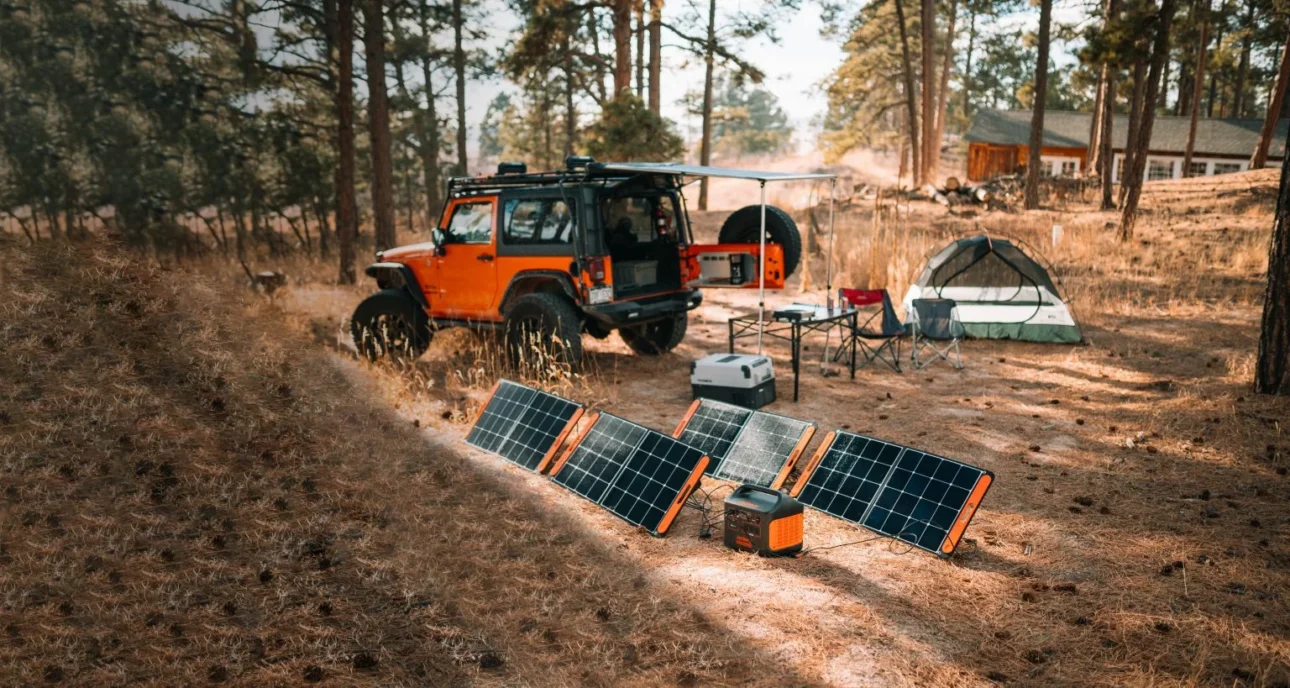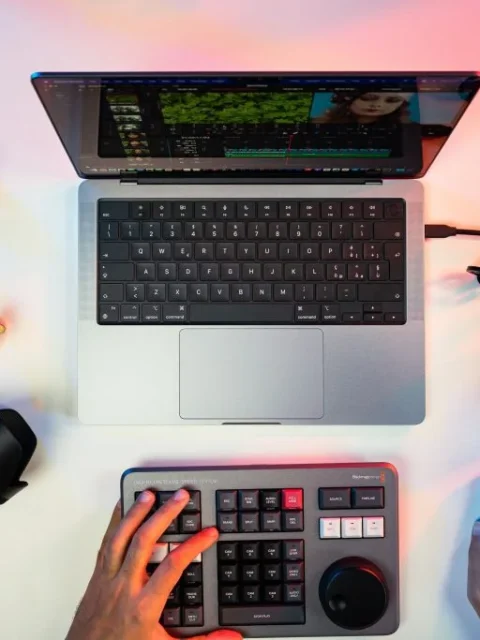The leisure battery system in your DIY van conversion is one of the most important parts of your build to get right, but with so many different options available it can be difficult to decide what type of battery is best for your campervan.
In this guide, we’ll compare all of the most popular options, including the advantages, considerations, and unique features of each, helping you to make an informed decision that aligns perfectly with your van conversion needs.
What to consider when choosing batteries for your campervan
1. Budget Considerations
We get it, building your dream van is expensive, so for most of us budget is always going to be a big factor. When it comes to batteries, you’ll find a range of options to fit various budgets – lead-acid type batteries are often the more affordable choice, and lithium batteries, while pricier, offer some convenient benefits. It’s essential to strike a balance between cost and quality, making sure you invest in batteries that won’t leave you stranded – more about this later on!
2. Space & Weight Constraints
Living the van life means embracing the minimalistic approach, and every inch counts. Batteries can be bulky and with limited space inside your camper van, you’ll want to maximize the room you have. Additionally, weight is a crucial consideration, as every pound adds up and affects your van’s overall performance and fuel economy. Consider more compact and lightweight batteries that won’t weigh you down on your cross-country adventures.

3. Usage Requirments & Battery Capacity
Before diving into battery options, take some time to evaluate your power requirements. Consider all the electrical goodies you plan to have in your van—lights, fridge, ventilation fans, gadgets, and more. Make a list of these energy-hungry devices so you can get a clearer picture of your daily power consumption. It’s essential to know how much juice you’ll need to keep everything humming along smoothly during your adventures, as well as how frequently you plan to hook-up to mains power.
4. Deep Cycle Capabilities
What is a deep cycle leisure battery?
Unlike starter batteries designed for short bursts of high power, deep-cycle batteries are specifically crafted to handle prolonged discharging and recharging cycles. The deep cycle capability of a leisure battery determines what percentage of the total capacity you can use before causing irreversible damage to the battery.
For example, a cheap 100Ah lead-acid battery might only be able to handle a total discharge of 50%, meaning it’s usable capacity is actually only 50Ah. A 100Ah lithium battery, on the other hand, can safely be discharged to around 80%, giving you more power from the same battery capacity.
So How Much Power Does Your Campervan Really Need?
Picture this: you’re out on the open road, and your van is your cozy home away from home. From the twinkling lights above your kitchenette to that trusty fridge keeping your snacks chilled, every little appliance and device contributes to your van life bliss. But to make it all work harmoniously, you need to know how much power each device consumes.
How to calculate how much battery power you need?
- Make a List: Take the time to create a list of all the electrical appliances you plan to have in your van – lights, fridge, ventilation fans, gadgets and anything you’ll need to recharge.
- Determine Wattage: For each item on your list, find out its power consumption in watts – you can usually find this information on the product label or in the user manual (or just google it).
- Calculate Daily Energy Consumption: Multiply the wattage of each device by the number of hours you plan to use it per day to give you the watt-hour value. Then add up the total watt-hours for all devices to get your daily energy consumption.
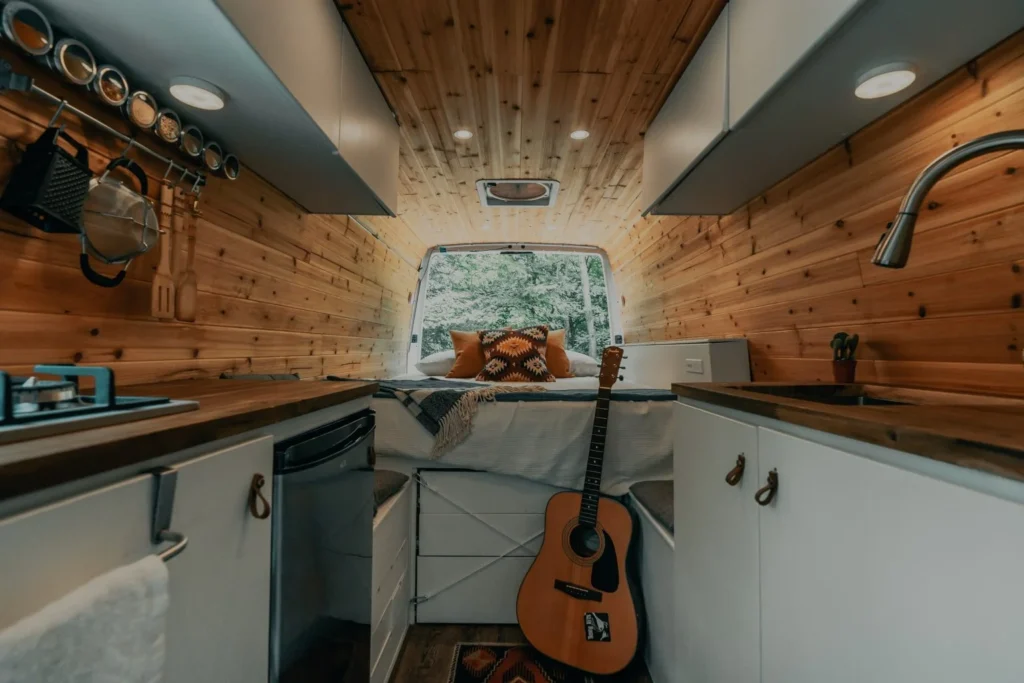
What size of leisure battery do you need for your campervan?
Now that you have a good grasp of your power needs, it’s time to talk battery capacity. Battery capacity, measured in ampere-hours (Ah), represents how much energy a battery can store and determines how long your batteries can power your devices before needing a recharge.
How to calculate your required battery capacity?
- Add Up Daily Energy Consumption: Sum up the daily energy consumption (in watt-hours) of all the devices from your list.
- Calculate Battery Capacity in Ampere-Hours: Simply divide your total daily watt-hour value by the voltage of the battery system (12v) to calculate the total daily battery capacity usage in amp-hours. In theory, you can use this to determine how many days of usage you will get from a full charge of your batteries, depending on their usable capacity.
- Factor in Efficiency and Battery Discharge Depth: Keep in mind that not all the energy stored in a battery is usable. Lead-acid batteries, for instance, are typically only discharged to about 50% of their capacity to maintain their lifespan. For lithium batteries however, you can utilize a higher percentage of their capacity.
- Add a buffer: Aim for a capacity that is higher than your estimated daily consumption to handle unexpected power spikes and extend the battery’s lifespan.
What kind of battery do you need for a campervan conversion?
When it comes to powering your dream van conversion, choosing the right battery is a crucial decision. The battery you select will determine how efficiently you can run your appliances, gadgets, and lights while living life on the road. In this section, we’ll explore the different types of batteries commonly used in van conversions, each with its own set of advantages and considerations.
1. Flooded Lead-Acid Batteries
Flooded lead-acid batteries are the most budget-friendly option among lead-acid batteries, making them a popular choice for those on a tight budget. They have been around for a long time and are known for their reliability and steady performance.
Although they require regular maintenance to check and refill water levels, which can be a hassle for some van lifers, are widely available, and you can easily find replacements if needed.
2. AGM Batteries
AGM batteries are maintenance-free and offer a spill-proof and vibration resistant design, perfect for those seeking a hassle-free option, especially for off-road adventures. They are more efficient at charging and discharging compared to flooded lead-acid batteries, however they are less tolerant of deep discharges compared to some other battery types.
Platinum AGM Plus
The Platinum AGM Plus Battery has an increased cycle capability compared to the flooded model, allowing the battery to be discharged and recharged over 360 times, offering better value in the long run despite being slightly more expensive upfront.
Pros
- Maintenance free
- Leak-proof design
- Vibration Resistant
Cons
- Limited usable capacity
- More expensive than lead acid

3. Gel Batteries
Gel batteries are known for their deep discharge capabilities and ability to handle extreme temperatures. While they cost a bit more than flooded and AGM batteries, their resilience makes them suitable for those expecting challenging weather conditions during their van life journey.
Gel batteries can also handle deep discharges better than flooded and AGM batteries, which can be beneficial for those who frequently draw their batteries down to lower levels. Proper charging control is essential, as gel batteries can be damaged by overcharging.
Photonic Universal Gel
A good choice if you need a budget option with a long potential lifespan and a little more resistance. The Photonic Universe is resistant to shock and vibrations, as well as having deep cycle discharge and recovery capabilities.
Pros
- Deep Discharge Capabilities
- Maintenance Free
- Resistant to Extreme Temperatures
Cons
- Less Efficient Charging
- Sensitive to Overcharging

4. Lithium Batteries
Although lithium batteries come with a higher upfront cost, their benefits more than make up for it if you have the budget. One of the most significant advantages of lithium batteries is their lifespan – it’s worth considering that they can outlive their lead-acid counterparts, which means fewer replacements and potentially a lower cost in the long run.
Lithium batteries are significantly lighter and more compact, making them ideal for small van spaces. Additionally, they are more efficient at charging and discharging, meaning you can use more of their stored energy without worrying about damaging the battery.
Renogy Lithium Battery
Aside from all the benefits of Lithium, this battery from Renogy comes with real-time monitoring and a powerful BMS system enabled by Bluetooth 5.0 technology, allowing you to track your battery’s status through the Renogy app. Weighing only 13kg, it’s super lightweight and compact, making it ideal for smaller spaces.
Pros
- Deep Discharge Capabilities
- Compact & Light
- Highly Efficient
- Long Lifespan
Cons
- Most Expensive

5. Portable Power Stations
In addition to traditional battery options like lead-acid and lithium batteries, another versatile and convenient power solution for off-grid van conversions is portable power stations.
Brands like Jackery offer portable power stations that combine a battery pack, inverter, and charging ports in a compact, all-in-one unit. These power stations provide a plug-and-play solution, allowing you to easily power your devices and appliances wherever you go.
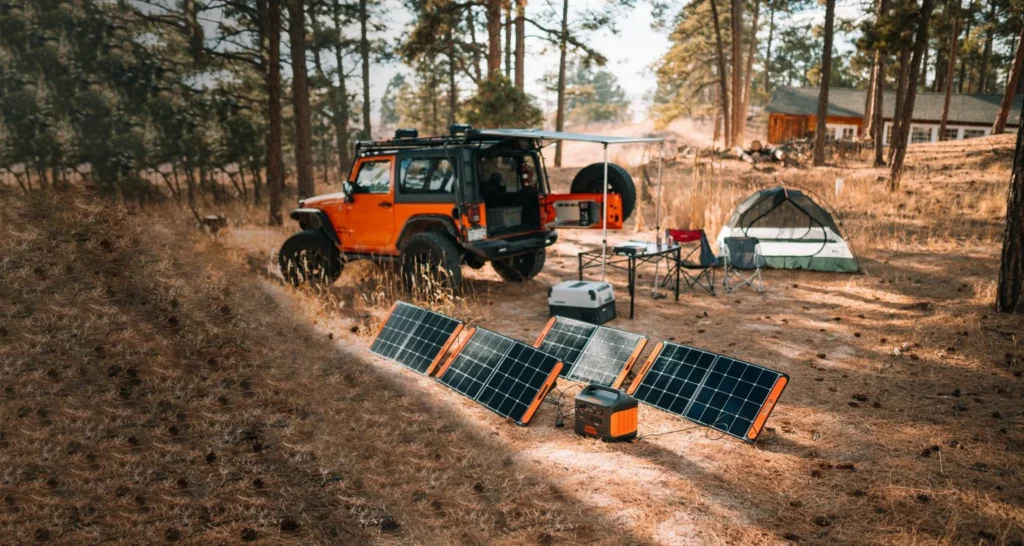
Portable power stations are ideal for short trips, day excursions, or as backup power sources. They often come with various output options, such as AC outlets, USB ports, and DC ports, enabling you to charge or run multiple devices simultaneously.
While portable power stations may not provide the same energy storage capacity as larger battery setups, their convenience and ease of use make them a popular choice for van lifers seeking portable power solutions on the go.
Jackery Portable Power Station
The Jackery portable power stations allow you to charge multiple devices at once using either USB or 240V AC power. They come in a range of sizes from as small as 16Ah to keep your devices charged during a long weekend, to over 150Ah to power your gadgets for days on end. Additionally, you have the option to recharge the power bank with portable solar panels for a super convenient and beginner friendly solar setup.
Pros
- No Set-up or Installation
- Portable
Cons
- Expensive
- Relatively Low Capacity

How to Keep Your Leisure Batteries Topped Up – The Best Charging Solutions
Now that you know your power needs and have the perfect battery capacity in mind, it’s time to talk about how to keep those batteries juiced up and ready for your next adventure. A reliable charging system is the lifeline of your van’s electrical setup, ensuring you have power when you need it, wherever you happen to call home for the night.
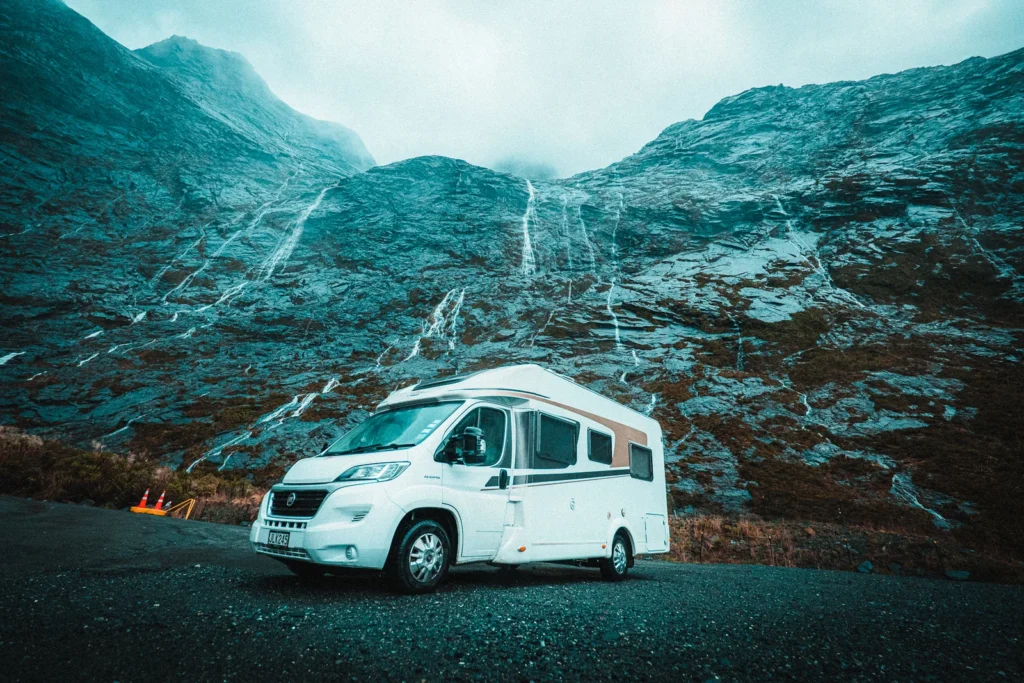
1. DC-DC Split Charger
Leverage the power of your van’s engine by installing a split charging system – as you drive you van’s alternator charges your batteries, keeping them topped up for your next destination. It’s an efficient and seamless solution, outputting significantly more power than solar alone and perfect for those who love to be on the move.
Renogy DC-DC Split Charger
The Jackery portable power stations allow you to charge multiple devices at once using either USB or 240V AC power. They come in a range of sizes from as small as 16Ah to keep your devices charged during a long weekend, to over 150Ah to power your gadgets for days on end. Additionally, you have the option to recharge the power bank with portable solar panels for a super convenient and beginner friendly solar setup.
Pros
- Fast Charging
Cons
- Need to be driving to charge
- Can speed up alternator wear

2. Solar Panel Kit
Usually mounted on your van’s roof, although they can be portable, solar panels convert sunlight into electricity, providing a sustainable and eco-friendly charging source. They are especially great for extended off-grid stays, giving you the freedom to chase sunny days while reducing your carbon footprint. Although nowhere near as powerful as alternator charging, on sunny day, solar panels have the advantage of working all day without needing your engine running
Renogy Solar Panel Kit
Everything you need to install you solar system right out of the box, including solar panels, charge controller, safe wiring and mounting brackets. This kit comes with the more efficient MPPT type charge controller to help get the most battery juice possible. It’s by far the easiest way to get started.
Pros
- Relatively Easy Installation
- Constant Daytime Charging
Cons
- Slow Charging Compared to DC-DC
- Power Dependent on Weather

3. Shore Power / Inverter Charger
With a shore power set-up, when you’re at a campsite or RV park, you can simply connect your van to a power outlet to charge your van’s batteries from a mains power source.
The easiest way to achieve this is with an inverter charger (not just an inverter) – not only does it allows you to convert the DC power stored in your lithium batteries into AC power (which is the type of power most household appliances and gadgets use), when you’re connected to shore power, an inverter charger allows your batteries to be recharged safely and efficiently.
Remember, you can’t do this with an inverter and shore power input alone as this will only supply power to your electrical system while it is connected, without actually recharging your batteries.
Renogy Inverter Charger
This pure sine wave inverter charger from Renogy not only allows you to power your household appliances, but also functions as a battery charger when connected to shore power, making it the perfect companion to your solar charging system.
Pros
- Fast Charging
- Constant & Unlimited Power
Cons
- Most Expensive
- Requires an External Power Source

QUICK TIP
Remember to install a battery monitor to keep an eye on your batteries health and prevent overcharging or over-discharging, which can lead to premature battery wear and potential damage.


